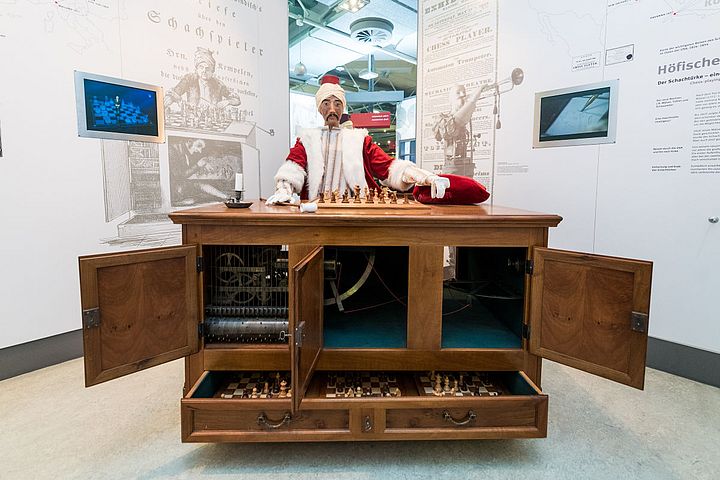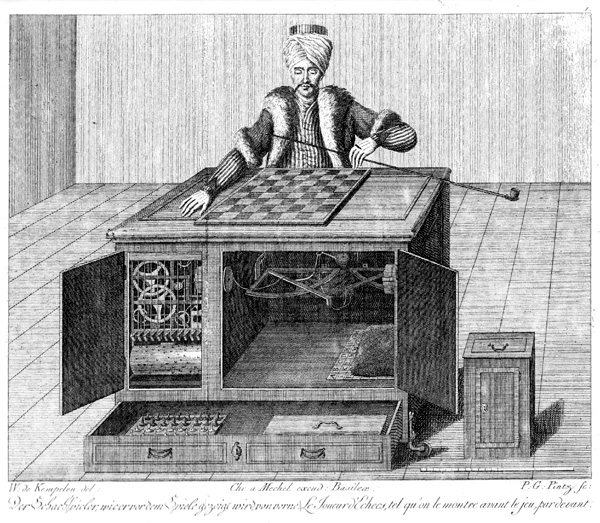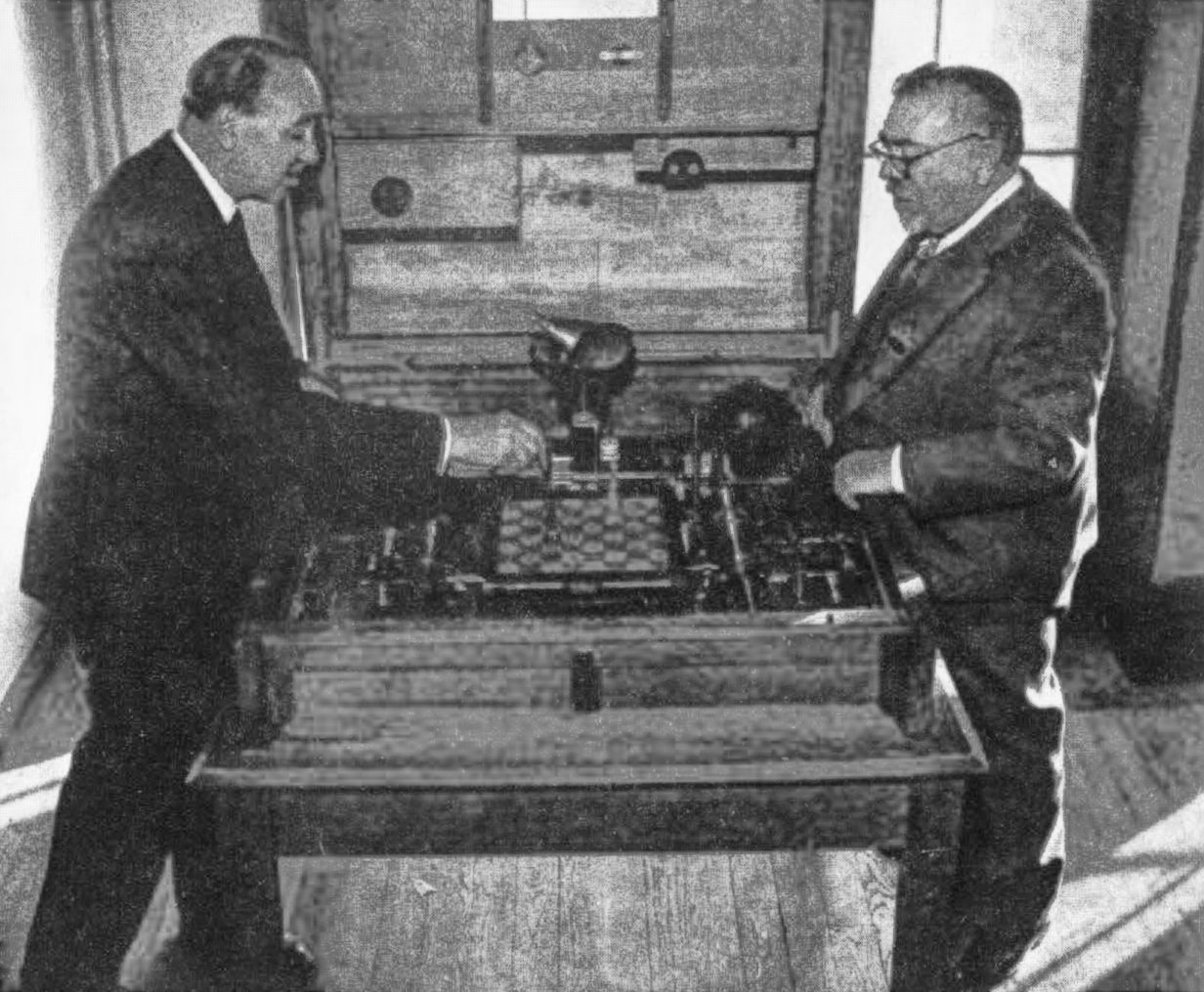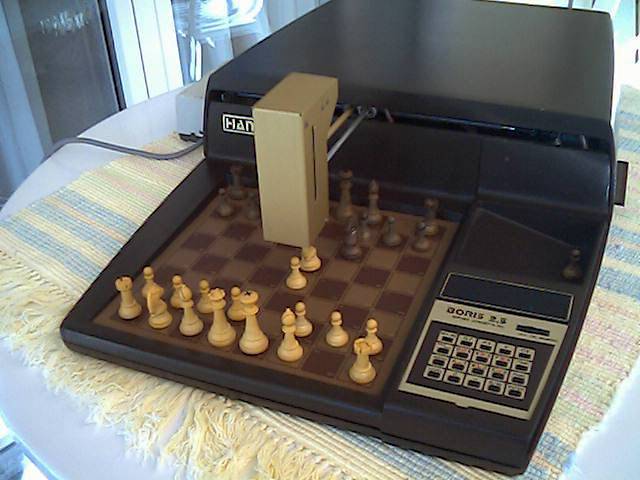by Albert Silver
7/27/2022 – By now it is almost impossible to not have heard the tragic tale of the 7-year-old boy whose finger was broken during an exhibition by a chess playing robot. It was certainly the least likely incident one would have imagined, but Murphy's Law was in full swing that day. Still, the history of robots and chess has been ongoing for over 250 years now, with robot chess players today in the homes of proud owners.

It really is no exaggeration to state that our fascination for chess playing robots goes back over 250 years. The first such example was the famed 'The Turk', a machine that purported to be a fully functioning chess automaton. Although this was in fact an amazingly elaborate hoax, it was not so fictitious as to be P.T. Barnum level.
The Turk
Constructed and unveiled in 1770 by Wolfgang von Kempelen to impress Empress Maria Theresa of Austria, the mechanism appeared to be able to play a strong game of chess against a human opponent. However, The Turk was in fact a mechanical illusion that allowed a human chess master hiding inside to operate the machine.

Although it was a smash hit, it was a curious tale of being a victim of its own success. Kempelen was understandably delighted by the success and popularity of his device... at first, but he soon began to balk at showing or sharing it with anyone for years on end, in spite of financial incentives. We are talking royal incentives no less.
The interior of the machine was very complicated and designed to mislead those who observed it. It was designed in such a way that when the front doors were open, people would see elaborate cogs and gears, and if both the back and front doors were opened at the same time one could see through the machine, even with the full-sized adult operator in the machine.
Take a minute to let that sink in. The degree of ingenuity of the entire project is truly staggering.
The story goes that in 1769, a famous French illusionist, François Pelletier, was performing one of his acts at the court of Maria Theresa of Austria at Schönbrunn Palace. Pelletier was famous for his employment of magnets to power many of his illusions. An exchange afterward resulted in Kempelen promising to return to the Palace with an invention that would top the illusions. And in 1770 he unveiled his astounding creation.

A full recreation can be seen at the Heinz Nixdorf Museum on permanent display
Consider that he needed to not only meticulously design the entire contraption before even tightening a single cog, but designed it to be both functional and illusion at the same time. He then needed to produce each and every piece that it was made of, and of course test it. Much has been made of the fact that it was a 'hoax', but it really was a work of genius.
In 1804, after Kempelen passed away, his son sold it to Johann Nepomuk Mälzel, who went to work restoring and improving it as an exhibition piece, even going so far as to add a voice box in 1818 that would say "Échec!" (French for "check") during matches.
Though it was indeed a hoax inasmuch as it was not a genuine automaton, those who paid to play it were still being serviced with a game by a proper chess master. The last and longest one to man it was the European chess master, William Schlumberger, known to have taught Pierre Charles Fournier de Saint-Amant, one of the greats of the 19th century.
The first true automaton
It would be 140 years before the first true chess automaton would make its appearance. In 1912 a Spanish engineer, Leonardo Torres y Quevedo, built what is widely considered not only the first true computer chess machine, but the first computer game of any kind. His chess machine 'Ajedrecista', was able to automatically play the endgame rook and king against the lone king using electromagnets under the board.

Gonzalo, Torres's son (left), showing his automaton to Norbert Wiener at the 1951 Paris Cybernetic Congress
In fact, not only could it play with no outside assistance, but if an illegal move was made by the opposite player, the automaton would signal it by turning on a light. If the opposing player made three illegal moves, the automaton would stop playing.
The commercial chess robots
Boris Handroid (1980)
The first commercially available chess robot was a curious device called the Boris Handroid. This curious device was announced in 1980 and was only available via special mail order. For many years it was a genuine unicorn of a device, and many collectors and aficionados wondered whether it even existed until a single copy surfaced, owned by a Swiss, Rolf Bühler.

A photo of the Boris Handroid (source: Rolf Bühler)
This singular device not only recognizes the movement of the figures controlled by the human opponent, but is also able to execute its own moves via a robotic arm controlled by three servomotors. The device has 7 game levels and contains the same chess program Sargon 2.5 as the MGS multi-game system.
Novag Robot Adversary (1982)
The first chess robot that became available in department stores and specialty shops came out in 1982, the legendary Novag Robot Adversary. This machine came with a very modern looking mechanical arm that will fold and unfold as its pincers pick up and move its pieces. It was a sight to behold, but unfortunately the failure rate was quite high and only some 2000 were produced.
Milton Bradley "Grandmaster" (1983)
Fat Fritz 2
Fat Fritz 2.0 is the successor to the revolutionary Fat Fritz, which was based on the famous AlphaZero algorithms. This new version takes chess analysis to the next level and is a must for players of all skill levels.
Shortly after, Milton Bradley came out with its own version of the robot chess machine, the Milton Bradley "Grandmaster". This machine instead operated with magnets under the pieces as it slid the pieces across the board to play the game.
This would prove to be extremely popular, and it led to a slew of machines by the company using this same core technology, and the defunct company Fidelity acquired the patent to produce their own and in 1988 out came the Fidelity Phantom, a very respectable machine, very similar in appearance, which sported a strong program by the Spracklens.
Though not the last of the robot machines, these were the most significant and pioneering contributions. The dedicated chess computer makers have all but disappeared, but you can still produce your own!
The Raspberry Turk
In the world of DIY (Do-It-Yourself) electronics, the inexpensive and immensely versatile Raspberry Pi, a small single-board computers (SBCs) developed in the United Kingdom is the swiss army knife of computer and electronic hobbyist projects. This is because of its low cost, modularity, and open design, not to mention its adoption of the HDMI and USB standards.
Sure enough, someone not only created a set of detailed plans to build your own chess robot, but teaches you how to do it.
Josh Meyer, the creator, has set up a website dedicated to showing how anyone can build their own, and it is entirely open source. If you are looking for an advanced but intriguing project, this is surely one for your shortlist.
Technological demonstrations
Needless to say, there are also much more advanced machines designed to not only play chess, but demonstrate advances in robotics. When it comes to chess and robots it is no surprise that the main sources are Russian.
Ten years ago, a public demonstration between a fully automated robot playing on a normal chess board and clock was arranged between top GM Alexander Grischuk and the machine. While the games went fine, it wasn't without some slightly startling moments...
Unfortunately, as was bound to happen, an accident happened a few days ago in a story that has gone viral, reported by the major media outlets around the world, such as The Guardian, CNN, and so many more.
The Guardian - Chess robot grabs and breaks finger of seven-year-old opponent
A 7-year-old boy was playing in one such demonstration, but his finger was caught by the machine and because of its strength, was broken. Understandably this caused surprise and alarm as is warranted, but it is incredibly rare and no doubt further safety measures will be put in place as a result.
Regardless of one's feeling on the matter, there is little doubt that robots will be playing an every greater role in our lives, though we are not quite at the stage where Isaac Asimov's Laws of Robotics will be a factor.

Albert SilverBorn in the US, he grew up in Paris, France, where he completed his Baccalaureat, and after college moved to Rio de Janeiro, Brazil. He had a peak rating of 2240 FIDE, and was a key designer of Chess Assistant 6. In 2010 he joined the ChessBase family as an editor and writer at ChessBase News. He is also a passionate photographer with work appearing in numerous publications, and the content creator of the YouTube channel, Chess & Tech.
No comments:
Post a Comment